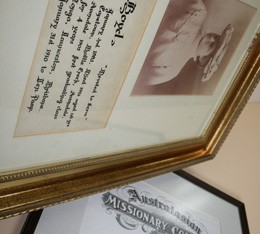The story behind the naming of Ella Boyd Hall
Sonja Larsen
Public relations assistant
Avondale College of Higher Education
Cooranbong, New South Wales, Australia
The story behind the naming of Ella Boyd Hall—opened in 1989—eludes most staff members and students at Avondale College of Higher Education. The women’s residence is simply a home for senior female students—a home with rooms whose main feature is a sink.

“Devoted to serve:” So reads the citation below a photograph of Ella Boyd that hangs in the residence bearing her name. The citation and photograph appear with a copy of Ella’s testamur. Credit: Sonja Larsen.
Even senior honorary research fellow Dr Milton Hook in his book Avondale: Experiment on the Dora says it is difficult to establish a reason for the name.
Ella Boyd is not the first female student nor the only female among the first graduates in 1902, writes Milton. The reason for the naming of Ella Boyd Hall “appears to be one based on sentiment.”
Childhood
Ella Boyd (1883-1951) is the daughter of Charles and Mary (Maud Sisley) Boyd, the first Seventh-day Adventist missionaries to serve in Africa. She received her education in Cape Town, South Africa, in Battle Creek, Michigan, USA, and in Cooranbong at the then Australasian Missionary College after sailing with her mother and grandmother to Australia at 17 years of age.
Life at Avondale
Ella’s life at Avondale in 1902 would now appear so foreign and quaint to residents of Ella Boyd Hall in 2011.
For example, the 40 vehicles lining the Ella Boyd Hall car park would have been unimaginable in 1902—students traveling to college were given the following advice: “Passages by boat should be booked to Sydney. . . . Railway tickets should be purchased to Morisset railway station where students will be met by a conveyance from the school, provided notice by letter or telegram has been previously sent giving notice by what train they will arrive” (Fifth Annual Announcement of the Avondale School for Christian Workers).

These items, now in the Adventist Heritage Centre, belonged to Ella Boyd during her time as a student at Avondale. Credit: Brenton Stacey.
And the “home regulations” of 1902 note separate strolling grounds for gentlemen and ladies, with permission to “pass beyond the limits” only given on request. Running up and down stairs or boisterous deportment in the halls: not permitted. The regulations even pertain to parents, who are not to send boxes of food—with the exception of fruit—to their children. The aim: to ensure students maintained a healthy diet.
Like mother, like daughter
While published information about Ella is limited, if the saying, “Like mother, like daughter,” is true, Maud’s personality helps us understand a little of Ella’s.
Maud, the first woman to serve the Adventist Church as a missionary, is a former matron, preceptress and teacher at Avondale who also worked as a Bible instructor in England, Australia and the United States until her retirement. Dorothy Minchin-Comm notes her endurance, enthusiasm and “courage in rising above loss and hardship” (Adventist Review, March 3, 1994, p. 12-13), including the death of a daughter and of a husband. Maud fulfilled Adventist pioneer Ellen White’s vision that she and her siblings would become workers for God.
Ella’s testamur acknowledges her good character. The certificate reads, “Ella Sisley Boyd, having completed in a credible manner the teacher’s course of study as prescribed by this Institution, and having given satisfactory evidence of a good moral character, is now granted this diploma.”
Life after Avondale
After graduating, Ella taught in Tonga, where she helped establish a school, then in Launceston, Tasmania, and in Brisbane. In 1910, Ella married New Zealander Leonard Paap, and together they returned to the mission field.
And that is appropriate because while the Avondale of Ella Boyd’s day has changed, its mission has not. Avondale continues to prepare students for lives of service by giving them “a greater vision of world needs.”
